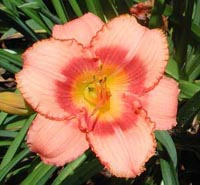Resource Library
Plant of the Week: Tetraploid Daylily
The University of Arkansas System Division of Agriculture does not promote, support or recommend plants featured in "Plant of the Week." Please consult your local Extension office for plants suitable for your region.
Plant of the Week
Tetraploid Daylily
Latin: Hemerocallis 'Strawberry Candy'

Gardeners not yet bitten by the daylily bug often consider these summer blooming perennials to be ho-hum flowers with boring orange blossoms. This stereotypical view is far from reality.
During the last two decades the daylily of our grandparents garden has been transformed into the rainbow of colors we see today by a throng of dedicated hobby breeders who have named over 50,000 selections. Much of this improvement has been by using tetraploid selections.
Daylilies typically have 22 chromosomes in the nucleus; cultivars developed with this basic set of chromosomes are referred to as diploids. Tetraploid daylilies have 44 chromosomes, twice the normal somatic number for the species. A few daylilies, most notably the orange daylily seen across the state in roadside ditches, are sterile triploids with 33 chromosomes.
When we think of chromosome numbers, which admittedly is not all that often, it is assuring to believe this basic building block of life is stable and never-changing. But occasionally things can go awry. If some extreme environmental shock occurs during a critical period of cell division or fertilization, the number of chromosomes can spontaneously double in a cell. It has been estimated that about half of the plants we grow in our gardens have examples of this spontaneous chromosome doubling. Since breeders started monkeying around with chemicals the number of polyploid species is even greater.
Plants with more chromosomes tend to have more substance than their diploid cousins. Tetraploid daylilies have larger and thicker leaves and flowers, stronger flower scapes, more intense coloration and increased vigor. Because of the difference in the number of chromosomes, diploid and tetraploid daylilies cannot be crossbred to produce new types. While most of the major daylily awards have gone to diploid selections, much of the excitement among daylily enthusiasts in the last few years has been about tets.
Artificial manipulation of chromosome numbers began in 1937 when it was discovered that a potent alkaloid drug called colchicine, extracted from the bulbs of the autumn crocus, caused chromosome doubling in a wide array of plants. By the late 1940's this discovery was being used as a topic of research projects for several students pursuing advanced degrees in plant breeding. Either established plants or seedlings can be transformed to tetraploids using colchicine.
The first tetraploid daylilies bloomed in California in 1947, but they were a far cry from what breeders have been able to develop in the subsequent decades. The first tetraploid daylily to win the Stout Award, the highest award given by the American Hemerocallis Society, was a yellow flowered cultivar called ‘Mary Todd’ that won in 1978. Since 1996 all of the Stout Award winners have been tetraploids.
It takes about a decade for an outstanding daylily selection to shoulder itself to the front of the line and be noticed enough to begin winning awards. Patrick Stamile, a Florida hybridizer and grower, has been one of the most prolific tetraploid breeders, winning three of the Stout awards since 1996. ‘Strawberry Candy’ won the award in 1998 and is a beautiful two-tone pink.
Few garden perennials are easier to grow than daylilies. They require at least six hours of sunlight and a reasonably fertile soil, but otherwise are undemanding. Topdressing with a balanced fertilizer in the spring as plants emerge and once or twice during the summer to ensure good bloom display.
Depending on how soon you want to divide, plants can be planted on 16- to 24-inch centers. Plants spaced close together will need division every three or four years. Division can be done at any season but fall or early spring is considered the best time.
By: Gerald Klingaman, retired
Extension Horticulturist - Ornamentals
Extension News - June 13, 2003
The University of Arkansas System Division of Agriculture does not maintain lists of retail outlets where these plants can be purchased. Please check your local nursery or other retail outlets to ask about the availability of these plants for your growing area.